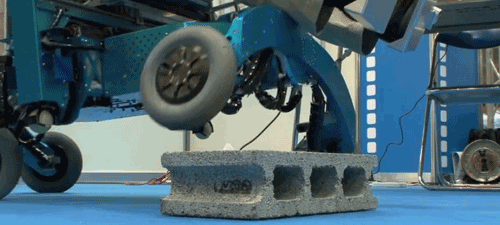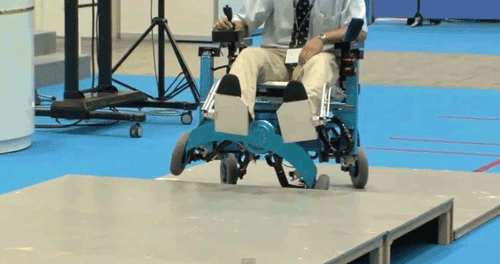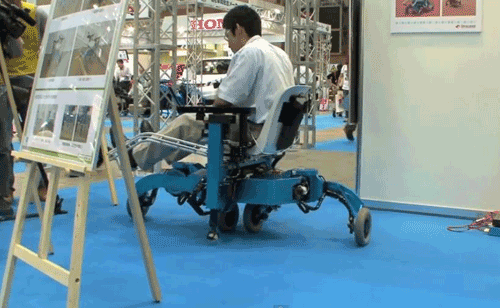Stairs are no problem for this four-legged wheelchair
Researchers develop wheelchair device with leg-like movements
Researchers out of Japan’s Chiba Institute of Technology have developed a robotic wheelchair that can cruise along paved surfaces and easily climb stairs.

Researchers have developed a wheelchair capable of stepping over obstacles.
The group, led by Shuro Nakajima, created the prototype device using a motorized wheelchair with four-wheel drive and five axes. It rolls from spot to spot, and when it encounters an obstacle like a step or ditch, gets by using its wheels as legs.
Keeping it simple
This rolling / walking wheelchair is an impressive form of mobility: the rider uses a joystick to direct it where to go and when it encounters an obstacle, it automatically assesses the surrounding area and makes the adjustments necessary to get by — all without any additional input necessary from the rider.
It does this via the bevy of sensors that comes with it: there are sensors on its feet that allow it to sense anything around it; there are also sensors on the front of the chair that allow it to see how far it is from an upcoming step.

The wheelchair uses sensors to determine how high it needs to lift its leg when climbing a step.
The sensors also work together to assess how big a step is. If there’s an error in the assessment when the wheels touch the step — or any object for that matter — the wheel’s torque adjusts automatically to avoid any risk of destabilizing the chair itself.
Speaking of stabilization, when the sensors first detect a step or obstacle, the robot calculates if and how high it needs to lift its leg. While it’s doing this, the steering system at the rear of the chair prepares the wheels so that the front end legs can be raised stably, an added measure the group took to ensure greater safety for the rider.
Getting through tight spots
Using wheels was a conscious choice by the group. They explained that the reason why they went in this direction, as opposed to simply making a wheelchair that could walk, is because a wheelchair mostly cruises along normal, paved surfaces. That said, the best and most efficient way to get around is on wheels, not legs (bicycle, car . . . think anything with wheels, really).
Now, along with being able to overcome steps and ditches, the wheels can also be lined up with one another while the wheelchair extends its stabilizers to the right and left, thereby allowing it to turn a full circle in the same spot. The point of this is to make it easier for the rider to go in reverse or turn around, even in tight spaces like a hallway or doorway.

The wheelchair’s wheels can be aligned to allow the rider to fully turn around within the same footprint.
Video
Demonstration of the robotic wheelchair in action is below — while it shows the wheelchair to be fully functional, the group says that it’s still just a prototype model and that they want to try it out on a few more people to better its functionality before it hits the market.
Story, quotes, and video via diginfo.tv
■
Advertisement
Learn more about Electronic Products Magazine






